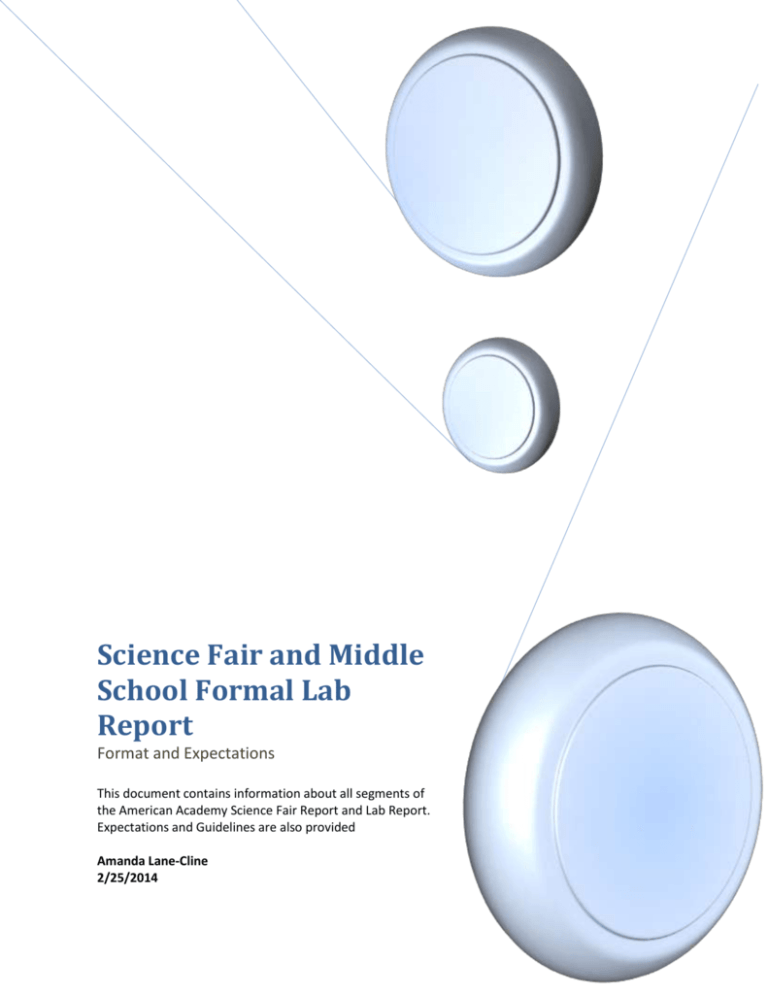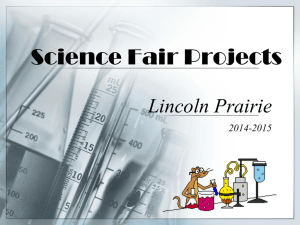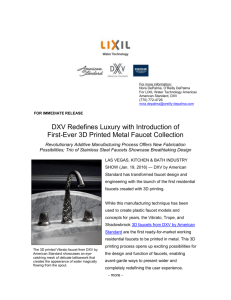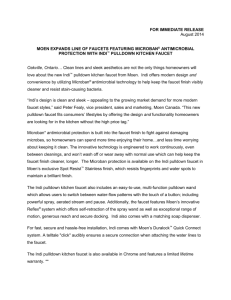Science Fair and Middle School Formal Lab Report
advertisement

Science Fair and Middle School Formal Lab Report Format and Expectations This document contains information about all segments of the American Academy Science Fair Report and Lab Report. Expectations and Guidelines are also provided Amanda Lane-Cline 2/25/2014 American Academy Formal Lab Reports and Science Fair The title says what you did. It also can have a catchy beginning followed by a colon. It should be brief (aim for ten words or less) and describe the main point of the experiment or investigation. An example of a title would be: Lights On: The Effects of Ultraviolet Light on Crystal Growth Rate. (science fair only) Summarize in a concise paragraph the purpose of the report (that is the scientific question), your hypothesis, how you performed your experiment, and present the data and major conclusions in about 150 - 200 words. Research paper with Introduction and Works Cited Page (Works Cited instructions on page 3, for science fair only) Describe the subject of the report, provide background information and report on what is known about the subject you are studying. Discuss why you are doing this study, why it is important and how the results could be relevant to other people. Experimental Plan: Purpose/Scientific Question This is the question you are trying to answer by your experiment. For example: “What are the effects of Ultraviolet Light on Crystal Growth Rate”. Hypothesis An educated guess about the answer to your scientific question is called the hypothesis. The hypothesis must be worded so that it can be tested in your experiment. Do this by expressing the hypothesis using your independent variable (the variable you change during your experiment) and your dependent variable (the variable you observe-changes in the dependent variable depend on changes in the independent variable). In fact, many hypotheses are stated exactly like this: "If a particular independent variable is changed, then there is also a change in a certain dependent variable." Example Hypotheses "If a plant receives fertilizer [having fertilizer is the independent variable], then it will grow to be bigger than a plant that does not receive fertilizer [plant size is the dependent variable "If the temperature of a cup of water is raised [temperature is the independent variable] then amount of sugar that dissolves will increase [the amount of sugar is the dependent variable]." Independent Variable/Dependent Variable/Controls Scientists use an experiment to search for cause and effect relationships in nature. In other words, they design an experiment so that changes to one item cause something else. These changing quantities are called variables. A variable is any factor, trait, or condition that can exist in differing amounts or types. An experiment usually has three kinds of variables: independent, dependent, and controlled. The independent variable is the one that is changed by the scientist. As the scientist changes the independent variable, he or she observes what happens. The scientist focuses his or her observations on the dependent variable to see how it responds to the change made to the independent variable. The new value of the dependent variable is caused by and depends on the value of the independent variable. For example, if you open a faucet (the independent variable), the quantity of water flowing (dependent variable) changes in response--you observe that the water flow increases. The number of dependent variables in an experiment varies, but there is often more than one. 1 Experiments also have controlled variables. Controlled variables are quantities that a scientist wants to remain constant, and he must observe them as carefully as the dependent variables. For example, if we want to measure how much water flow increases when we open a faucet, it is important to make sure that the water pressure (the controlled variable) is held constant. That's because both the water pressure and the opening of a faucet have an impact on how much water flows. If we change both of them at the same time, we can't be sure how much of the change in water flow is because of the faucet opening and how much because of the water pressure. In other words, it would not be a fair test. Most experiments have more than one controlled variable. Some people refer to controlled variables as "constant variables." Examples of Variables Question How much water flows through a faucet at different openings? Independent Variable (What I change) Water faucet opening (closed, half open, fully open) Dependent Variables (What I observe) Amount of water flowing measured in liters per minute Controlled Variables (What I keep the same) The Faucet Water pressure, or how much the water is "pushing" "Different water pressure might also cause different amounts of water to flow and different faucets may behave differently, so to insure a fair test I want to keep the water pressure and the faucet the same for each faucet opening that I test." List everything needed to complete your experiment. Describe the steps you completed during your investigation. This is your procedure. Be sufficiently detailed that anyone could read this section and duplicate your experiment. Write it as if you were giving direction for someone else to do the lab. It may be helpful to provide a Figure to diagram your experimental setup. (Results) Numerical data obtained from your procedure usually is presented as a table. Data encompasses what you recorded when you conducted the experiment. It's just the facts, not any interpretation of what they mean. & Graphs (Results) Organize data table into graphs, figures, and include photographs, etc. Graphs and figures must both be labeled with a descriptive title. Label the axes on a graph, being sure to include units of measurement. The independent variable is on the X-axis. The dependent variable (the one you are measuring) is on the Y-axis. Be sure to refer to figures and graphs in the text of your report. of Results The discussion of results section is the analysis. This is where you interpret the data (describe what the graphs and figures are telling you). Describe in words what the data means. Determine whether or not a hypothesis was 2 accepted. Explain the logic that allows you to accept or reject the hypothesis. This is also where you would discuss any mistakes you might have made while conducting the investigation. Include suggestions for improving your techniques or design, or discuss why you might doubt your results. You may wish to describe ways the study might have been improved. Conclusions Most of the time the conclusion is a single paragraph that sums up what happened in the experiment, whether your hypothesis was accepted or rejected, and what this means. This is where you mention people who provided help during the science fair process, like your mentor, teacher or parent, or even other students. Works Cited in MLA format for Research Paper (science fair 6, 7, 8 only) You must to reference everything you write, otherwise you may be charged for plagiarism which is the intentional or accidental use of someone else's work as your own without recognition of their original ideas. General Guidelines Type your paper on a computer and print it out on standard, white 8.5 x 11-inch paper, Double-space the text of your paper, and use a legible font like Times New Roman or Courier. The font size should be 10-12 pt. Leave only one space after periods or other punctuation marks (unless otherwise instructed by your instructor). Set the margins of your document to 1 inch on all sides. Indent the first line of a paragraph one half-inch (five spaces or press tab once) from the left margin. Create a header that numbers all pages consecutively in the upper right-hand corner, one-half inch from the top and flush with the right margin. Formatting the First Page of Your Paper Make a title page for your paper that includes the project title, student name, and date all centered in the middle of the paper. In the upper left-hand corner of the first page, list your name, your instructor's name, the course, and the date. Again, be sure to use double-spaced text. Double space again and center the title. Don't underline your title or put it in quotation marks; write the title in Title Case, not in all capital letters. Double space between the title and the first line of the text. Create a header in the upper right-hand corner that includes your last name, followed by a space with a page number; number all pages consecutively with Arabic numerals (1, 2, 3, 4, etc.), onehalf inch from the top and flush with the right margin. MLA (Modern Language Association) The Modern Language Association (MLA) Style is widely used for identifying research sources. In MLA style you briefly credit sources with parenthetical citations in the text of your paper, and give the complete description of each source in your Works Cited list. The Works Cited list is a list of all the sources used in your paper, arranged alphabetically by author's last name, or when there is no author, by the first word of the title (except A, An or The). 3 For example: In the text of your paper: The first political Web site appeared in 1995, and online campaigning has since become the most popular Internet political strategy (Will 92). Or, George Will reported that in 2002 Internet campaigning surpassed TV commercials ads to become the Internet's most popular business (92). In your Works Cited list: Will, George F. "Electronic Politics." Newsweek 25 Nov. 2002: 92. The following examples are based on the MLA Handbook for Writers of Research Papers, 6th ed., by Joseph Gibaldi. (Ref LB2369 .G53 2003) For a book reference Author. Title of Book. City of Publication: Publisher, Year. This is the basic format for a Works Cited entry. Take the title from the title page, not the cover. The author's name should be written Last Name, First Name. Example- Brinkley, Alan. The Unfinished Nation. New York: Knopf, 1993. Two Authors List the names in the order they appear on the title page. Only the first author's name should be reversed: Last Name, First Name. Use a comma between the authors' names. Place a period after the last author's name. Example- Rowe, Richard, and Larry Jeffus. The Essential Welder: Gas Metal Arc Welding Classroom Manual. Albany: Three or More Authors List the names in the order they appear on the title page. Only the first author's name should be reversed: Last Name, First Name. Use a comma between the authors' names. Place a period after the last author's name. Example- Rowe, Richard, and Larry Jeffus. The Essential Welder: Gas Metal Arc Welding Classroom Manual. Albany: Delmar, 2000. 4 MAGAZINE ARTICLES Author. "Title of Article." Title of Magazine Date: Page(s). Abbreviate the months (except May, June, July). Give complete dates for magazines issued every week or every two weeks, written in this order: Day Month Year, e.g., 15 Jan. 2000 If the article is on consecutive pages, specify the page numbers of the entire article, e.g. 16-20. Give just the last two digits of the second number, when possible, e.g. 188-89, but 196-200 If the article is not on consecutive pages — if, for example, it begins on page 27, then skips to page 30, and continues on page 32 — write only the first page number, followed by a plus sign: 27+. Do not give volume and issue numbers for magazine articles. Example- Dominus, Susan. "Why Pretty Isn’t Pretty Enough Anymore." Glamour Jan. 2004: 136+. Example- Talcott, Richard. "Great Comets." Astronomy May 2004: 36-41. NEWSPAPER ARTICLES Author. "Title of Article." Name of Newspaper Date, edition: Page(s). Take the name of the newspaper from the masthead, but omit any introductory article: Honolulu Advertiser, not The Honolulu Advertiser. If the city of publication is not part of the newspaper's name, add it in square brackets: News and Observer [Raleigh, NC] Give the complete date, but not the volume and issue numbers. Specify the edition of the newspaper, if one is given on the masthead. If the article is not on consecutive pages, write the first page number and a plus sign: B1+. ExampleDaranciang, Nelson. "Traffic Offender Web Site Debated." Honolulu Star-Bulletin 8 Apr. 2004, night final ed.: A3. Journals ExamplesAuthor. "Title of Article." Title of Journal Volume number (Year): Page(s). Name of Database. EBSCOhost. Honolulu Community Coll. Lib., HI. Date of Access <http://search.epnet.com/>. Nelson, Roxanne. "Smoking Outside Still Causes Second-Hand Smoke Exposure to Children." Lancet 359 (2002): 1675. Academic Search Premier. EBSCOhost. Honolulu Community College Lib., HI. 8 May 2004 5 WEB SITES Complete publication information may not be available for a Web site; provide what is given. Title of the Site. Editor. Date and/or Version Number. Name of Sponsoring Institution. Date of Access <URL>. Example- Encyclopedia Mythica. 2004. 13 May 2004 <http://www.pantheon.org/>. INTERVIEWS Interview Conducted by the Researcher Person Interviewed. Type of Interview (personal, telephone, email, etc.). Date. Example- Nakamura, Michael. Personal interview. 23 July 2004. Broadcast Interview Add information for the television or radio broadcast. Example- Clinton, Bill. Interview with Larry King. Larry King Live. CNN. 24 June 2004. 6











